Hakea chromatropa is a species of shrub found in Southwest Australia. The distribution is restricted to an area around Wongan Hills, where it is found on gravelly loam in open shrubland. The flowers are white or creamy, becoming pink, and without a scent.

Hakea chordophylla, commonly known as bootlace oak, bootlace tree, corkwood, or bull oak, is a species of shrub or small tree in the family Proteaceae found in central and northern Australia. Bares very showy golden yellow, pale green or cream nectar rich flowers in winter.

Persoonia comata is a species of flowering plant in the family Proteaceae and is endemic to the south-west of Western Australia. It is an erect, sometimes spreading to low-lying shrub with mostly smooth bark, spatula-shaped to lance-shaped leaves with the narrower end towards the base and yellow flowers usually in groups of ten to fifty along a rachis up to 250 mm (9.8 in) long.

Hakea ambigua is a shrub in the family Proteaceae. In favourable conditions may grow into an attractive weeping shrub with creamy white flowers. Only found in the Stirling Ranges of southern Western Australia.

Hakea anadenia is a shrub in the family Proteaceae, native to near the west coast of Western Australia. The fragrant creamy-white flowers appear in profusion from late winter to spring, but do not produce nectar.
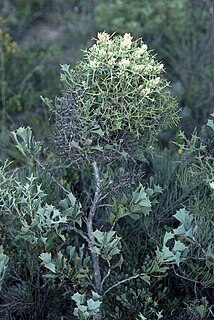
Hakea auriculata is a reasonably common shrub in the family Proteaceae endemic to Western Australia. A very showy species in full bloom with creamy white, yellow, dark red or reddish purple fragrant flowers.
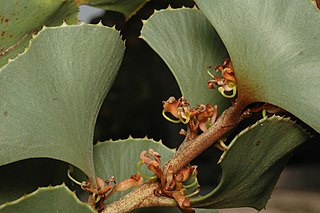
Hakea brownii commonly known fan-leaf hakea is a shrub in the family Proteaceae native to an area in the Wheatbelt region of Western Australia. This species shares a common name with Hakea baxteri due to its distinctive leaves.

Hakea candolleana is a shrub in the family Proteaceae native to areas along the west coast in the Wheatbelt and Mid West regions of Western Australia. A cream-white winter flowering species, useful as a garden ground cover.

Hakea costata, commonly known as the ribbed hakea, is a shrub in the family Proteaceae native to Western Australia. A multi-stemmed small shrub producing attractive pink or white brush-like blooms rich in nectar from July to October.
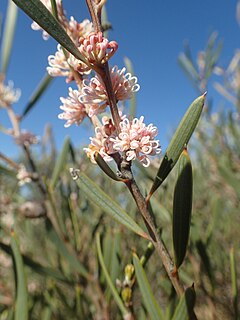
Hakea erecta is a shrub in the family Proteaceae and is endemic to Western Australia. It is a dense rounded shrub with linear twisted leaves and up to 24 pink or white fragrant flowers appearing in leaf axils in spring.
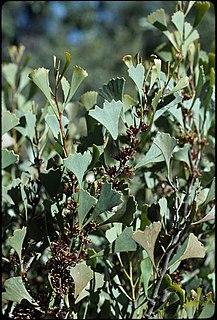
Hakea flabellifolia, commonly known as the fan-leaved hakea or wedge hakea, is a shrub in the family Proteacea. It is endemic to an area along the west coast in the Mid West and Wheatbelt regions of Western Australia.

Hakea gilbertii is a shrub in the family Proteacea and is endemic to an area in the Wheatbelt region of Western Australia. It is an upright, prickly shrub with greyish needle-shaped leaves and clusters of fragrant flowers from late winter to spring.

Hakea kippistiana is a shrub in the family Proteacea and endemic to Western Australia. It is a dense prickly shrub with sharp needle-shaped leaves with fragrant white, cream or pink flowers from November to February.

Hakea megalosperma, commonly known as Lesueur hakea, is a shrub of the genus Hakea native to a small area along the west coast in the Wheatbelt region of Western Australia. It is a small shrub with sweetly fragrant white or pink flowers, darkening as they age to red and thick egg-shaped bluish-green leaves.

Hakea meisneriana is a shrub in the family Proteaceae and is endemic to Western Australia. It has small, nectar rich, creamy white flowers in clusters in the upper branches from August to November.

Hakea pycnoneura is a shrub in the family Proteaceae. It has fragrant, pink-purplish flowers in the leaf axils. It is endemic to a small area on the west coast in the Mid West and a smaller area on the south coast in the Goldfields-Esperance regions of Western Australia.
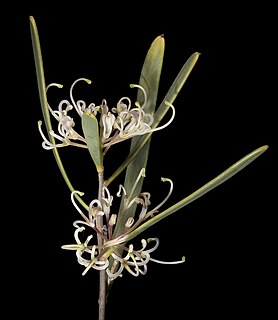
Hakea stenophylla is a shrub or tree in the family Proteacea, with sweetly scented creamy-white flowers. It is endemic to Western Australia.
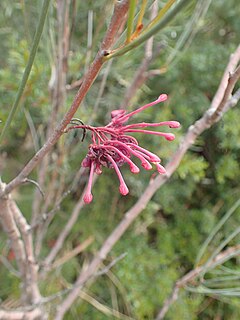
Hakea strumosa is a shrub in the family Proteacea endemic to an area in the Wheatbelt, Great Southern and the Goldfields-Esperance regions of Western Australia. A dense, very prickly shrub with a profusion of small, deep pink or red flowers in spring.
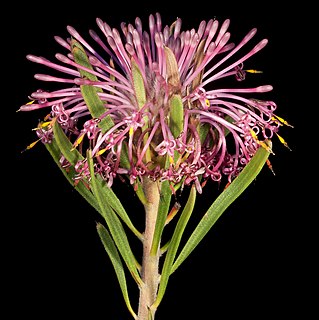
Isopogon linearis is a small shrub in the family Proteaceae that is endemic to the southwest of Western Australia.

Pimelea ammocharis is a species of small shrub in the family Thymelaeaceae. It is a small shrub with white-yellow to orange flowers and is endemic to Western Australia.




















